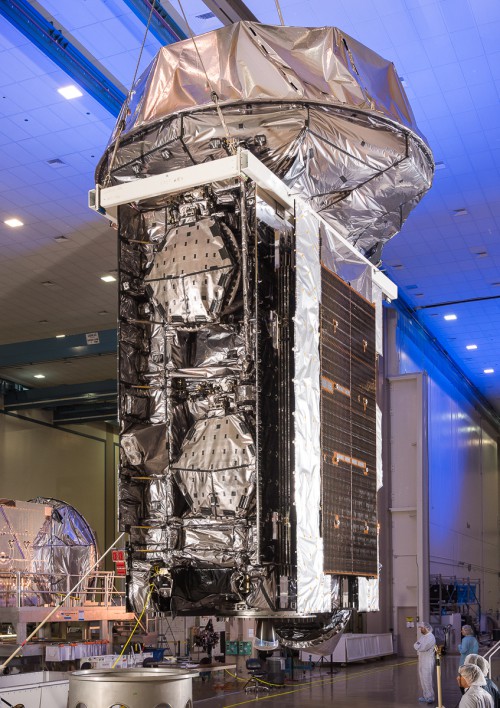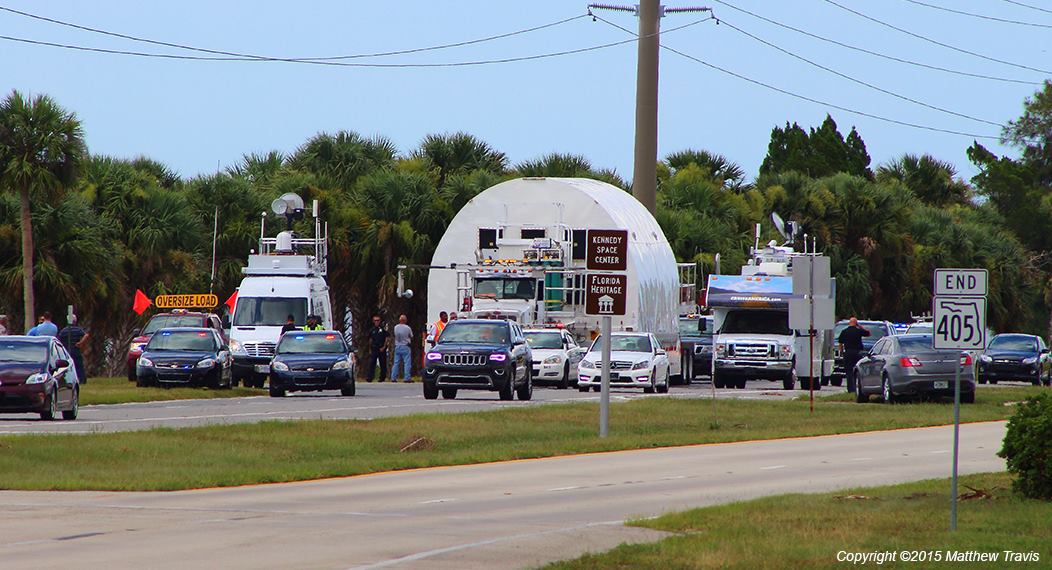
The fourth in a Lockheed Martin-built, five-ship fleet for a next-generation, narrowband tactical military satellite communications system has arrived in Florida for its August launch. The U.S. NAVY’s 7.5-ton Mobile User Objective System-4 (MUOS-4) arrived at Cape Canaveral Air Force Station on a C-5 Galaxy transport aircraft via Lockheed Martin’s Sunnyvale, Calif., facility and nearby Moffett Federal Airfield on June 28, courtesy of the 60th Air Mobility Wing of Travis Air Force Base.
“MUOS allows troops all over the world to talk, text and share mission data seamlessly, while traveling, like a cellular network, without having to worry about where they are in relation to a satellite,” said Iris Bombelyn, Lockheed Martin’s vice president for narrowband communications. “MUOS-4 will complete our near global coverage, reaching further north and south toward the poles than ever before.”

MUOS operates like a “smart phone cell tower in the sky,” supporting a worldwide, multi-Service population of users in the UHF band, providing increased communications capabilities to smaller terminals while still supporting interoperability with legacy terminals. The new military SATCOM system will, for the first time, give MUOS Wideband Code Division Multiple Access technology users beyond-line-of-sight capability to transmit and receive voice and data using an Internet Protocol-based system, giving users greater mobility, higher data rates, and improved operational availability.
MUOS gives military users more communications capability over existing systems, including simultaneous voice, video, and data—similar to the capabilities experienced today with smart phones and providing users with 10 times more communications capacity.
Launch is currently scheduled to occur atop a 206-foot-tall United Launch Alliance (ULA) Atlas-V rocket from Space Launch Complex-41 (SLC-41) no earlier than Aug. 27. The launch window has yet to be announced.
The satellite is currently at Astrotech Space Operations in nearby Titusville, where technicians will complete pre-launch processing and final preparations for liftoff. After completing post-shipment testing the satellite will be fueled, then encapsulate it inside the Atlas-V’s 5.4-meter (17.7-foot) bullet-like payload fairing. The encapsulated MUOS-4 will then be transported to SLC-41 on the Cape and be integrated on top of ULA’s workhorse rocket for final integrated testing and closeout preparations for launch.
Flying in its most powerful “heavyweight” 551 configuration, ULA’s Atlas-V will employ a full suite of five strap-on Aerojet Rocketdyne solid-fueled boosters to deliver the NAVY’s 15,000-pound satellite to geosynchronous orbit, more than 22,000 miles above Earth. The MUOS satellites are the heaviest payloads to ever fly on the Atlas-V.
ULA has launched 56 missions over 13 years on their Atlas-V fleet of rockets, all successfully, but only five of those missions required the heavyweight 551 configuration: New Horizons to Pluto in 2006, JUNO to Jupiter in 2011, MUOS-1, MUOS-2, and MUOS-3. Once launched a single-engine Centaur upper stage will give MUOS-4 the final push it needs to enter its intended orbit.
Although a total of five MUOS satellites will make up the MUOS fleet, only four will actually be required to put the whole system into action; the fifth and final MUOS to launch in 2016 will instead serve as an on-orbit spare, should any of the first four lose their capabilities.
Original plans called for the first MUOS to launch by 2010, but budgetary adjustments made in response to the Iraq war led to a two-year delay. MUOS-1 launched on Feb. 24, 2012, followed by MUOS-2 on July 19, 2013, and MUOS-3 on Jan. 20, 2015. In the time since they have demonstrated new capabilities, especially in the Arctic, an area previously beyond the coverage of UHF satellites and growing in interest for transportation and natural resources exploration above 65 degrees north latitude. In the past year MUOS successfully connected users near the Arctic poles during independent testing by Lockheed Martin, and during the U.S. Navy’s 2014 Ice Exercise (ICEX) and the U.S. Coast Guard’s Arctic Shield 2014.

The MUOS satellites seek to offer global satellite communications narrowband (64 kbits/sec and lower) connectivity for use by U.S. and allied forces, with an ultra-high frequency range from 300 MHz-3 GHz. When fully functional, it will replace the legacy UHF Follow-On (UFO) satellite network—the first of which was launched back in March 1993—before the latter system reaches the end of its operational service. MUOS will provide new capabilities and enhanced mobility, access, capacity, and quality of service, with particular emphasis upon mobile users, such as aerial and maritime platforms, ground vehicles, and dismounted soldiers.
By operating in the UHF frequency band, which is lower than that used by conventional cellular networks, MUOS will provide U.S. and allied warfighters with the tactical ability to communicate in “disadvantaged” environments, including heavily forested areas where higher-frequency signals would be otherwise impaired. Even troops in buildings with no satellite access are expected to see an increase in communications capability.
The infrastructure to both fly the MUOS satellites and control access of a user’s communications is managed from the ground. Operationally, information flows to the satellites via UHF WCDMA links, and the satellites then relay the information to one of four ground sites located in Hawaii, Virginia, Italy, and Australia via a Ka-band feederlink. These facilities identify the destination of the communications and route the information to the appropriate ground site for Ka-band uplink to the satellite and UHF WCDMA downlink to the correct users. MUOS will also provide users access to select Defense Information System Network voice and data services.
The MUOS network is expected to be operational by the end of 2015, and all four required MUOS ground stations are complete. According to Lockheed, over 55,000 currently fielded radio terminals can be upgraded to be MUOS-compatible, with many of them requiring just a software upgrade.
Be sure to “Like” AmericaSpace on Facebook and follow us on Twitter: @AmericaSpace
Missions » MUOS » MUOS-4 »




